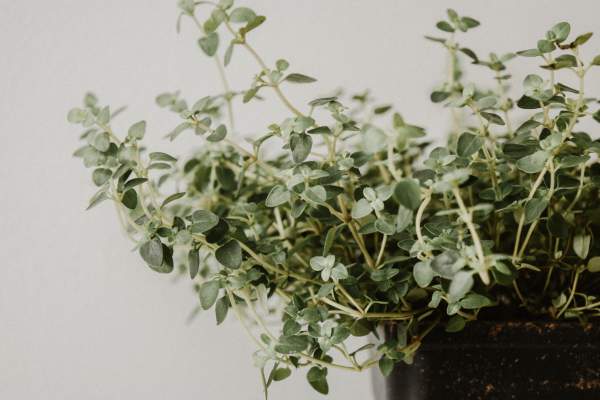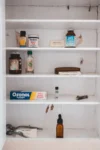I like to grow parsley, thyme, basil and oregano on hand as they’re the herbs I use most in my kitchen. When I have more room I grow mint, coriander and rosemary…
Growing your own herbs benefits you, since you save both money and time – and enjoy the convenience of fresh herbs exactly when you need them. It is also a great way to involve your children in preparing a meal (and convincing them to eat it).
In addition many herbs are known for their incredible healing powers thanks to their high nutritional levels. Full of antioxidants, vitamins and minerals herbs are also packed with flavour and easy to use.
I was lucky enough to grow up benefiting from the superior taste and nutrition of herbs and vegetables from my hippy mother’s organic kitchen garden. When I left home, I missed the convenience of popping out the door to gather a little of this or that to throw into a salad, steep in hot water for tea, or help the flavour of a cooked dish pop!
City living can really limit the time and space available to grow vegetables, but I always managed to find some sort of space to grow herbs. Over the years I’ve grown them in little pots inside, planter-boxes outside, in hanging baskets and even in jars of water on the kitchen windowsill.
Here is a quick guide on how to grow your own herbs, as well as how to use them.
Growing Herbs: Indoors or Outdoors?
Growing herbs is actually quite easy. Before you start planting and growing your herbs, you have to decide whether you want to grow them indoors or outdoors. This decision depends on your climate, space and accessibility.
Growing herbs indoors provides easy access; requires no weeding and gives you plenty of plants to harvest all year round. On the other hand, outdoor growing allows for a herb to develop more flavour and provides you with higher quantities to harvest. Outdoor gardens require more space though, and depending on your climate, may be limited to certain seasons of the year.
You might also consider a nice combination of indoor and outdoor plants using movable containers.
The Planting Process
No matter where you wish to begin, or what herb you begin with, you need a place with plenty of sunlight, well-draining potting soil and moderate temperatures.
The easiest way to start your herb garden is with pre-potted seedlings. Have you seen those little herb plants from the supermarket? I sometimes buy and simply plant them instead of having to go to a plant nursery to get seedlings.
Starting your kitchen herb garden from seeds is a little more work for beginners, but it is so rewarding to see a little plant shoot grow up through soil and is a great learning activity to share with your children. If you wish to begin with seeds, it is easiest to plant them indoors in little peat pots or empty cardboard egg cartons. You can even use finished toilet rolls or roll up newspaper into little planters . Simply fill them with soil and put two or three seeds in each (kids love doing this and it’s great for their fine motor skills). Make sure you regularly check they don’t dry out. After the seeds sprout (different herbs take different amounts of time), weed out the smallest sprouts so only the strongest one remains.
After five to ten weeks, you will be able to transplant them into their garden. Simply dig a small hole and plant the seedling, container and all, into it. The egg carton/toilet roll/newspaper pots will break down in the soil.
Some herbs can also be grown by simply planting cuttings of mature herbs – rosemary and mint for example.
Maintenance of Herbs
Herbs may be hardy plants, but they still require maintenance. They should never be watered too frequently, as they require moist – not soggy – soil. Indoor plants in pots require watering more often so they don’t dry out.
You also need to fertilise your herbs occasionally to boost nutrients and health. Indoor herbs also need to be fertilised more regularly due to their need for more watering. The best option for potted herbs are time-release fertilisers.
Regular pruning is also essential to prevent flowering and encourage growth. When you pick your herbs, try to pinch them off where they’d later need pruning.
If you are harvesting the leaves of the plant, try to pick them in the morning and before the plant begins to flower. Harvesting flowering herbs such as chamomile is best before the flowers fully open. You should dig up roots, such as ginger or turmeric, at the end of summer. If it is the seeds you are after, harvest them when the seed pods change colour.
Herb Storage
It is best to use garden herbs freshly harvested. However, sometimes you have too much and you’re left with a bunch of unused herbs.
You can put some herbs – cilantro, parsley and basil, for example – into a jar of water for a few days. Wrapping your herbs in a moist paper towel and storing in the refrigerator works for a bit longer – about a week. Or finely chop, pack into ice cube containers, top with water and freeze. Then simply pop a herb ice-cube into your cooking next time you need some.
Using the Herbs You’ve Grown
Herbs are typically woody or soft. Woody herbs like rosemary or thyme are tougher and more powerful, which means they are used sparingly due to their strong taste. Soft herbs, such as basil and parsley on the other hand, have more subtle flavourings.
Woody herbs are frequently dried to enhance their strong, rich flavours, while soft herbs should be used fresh. Fresh cut herbs will beat dried herbs any day in nutritional value.
When cooking with fresh herbs, always add them close to the end of the cooking time. This is because it is very easy to overcook fresh herbs and lose their wonderful aroma, flavour and nutritional benefits.
If you want to use fresh herbs but your recipe calls for dried, you will need three to four times more fresh herbs than dried herbs requested. Here is a guide to which herbs go well with different foods.
When preparing to use your homegrown herbs, it is important that your knives are sharp. Dull blades will crush and bruise your herbs instead of delivering a clean cut to preserve flavour and colour.
You might prefer to invest in a pair of herb scissors to avoid sharpening dull knives constantly.
Conclusion
People have been enjoying herbs for their powerful healing properties, wonderful flavour and nutritional benefits for thousands of years.
They are easy to grow whether indoors, outdoors, or a combination of both, and will save you time and money. As small as herbs may be, they add a potent punch to any dish that improves flavour, nutrition and presentation.
I hope this has inspired you to create your own herb garden. What will you start with?



